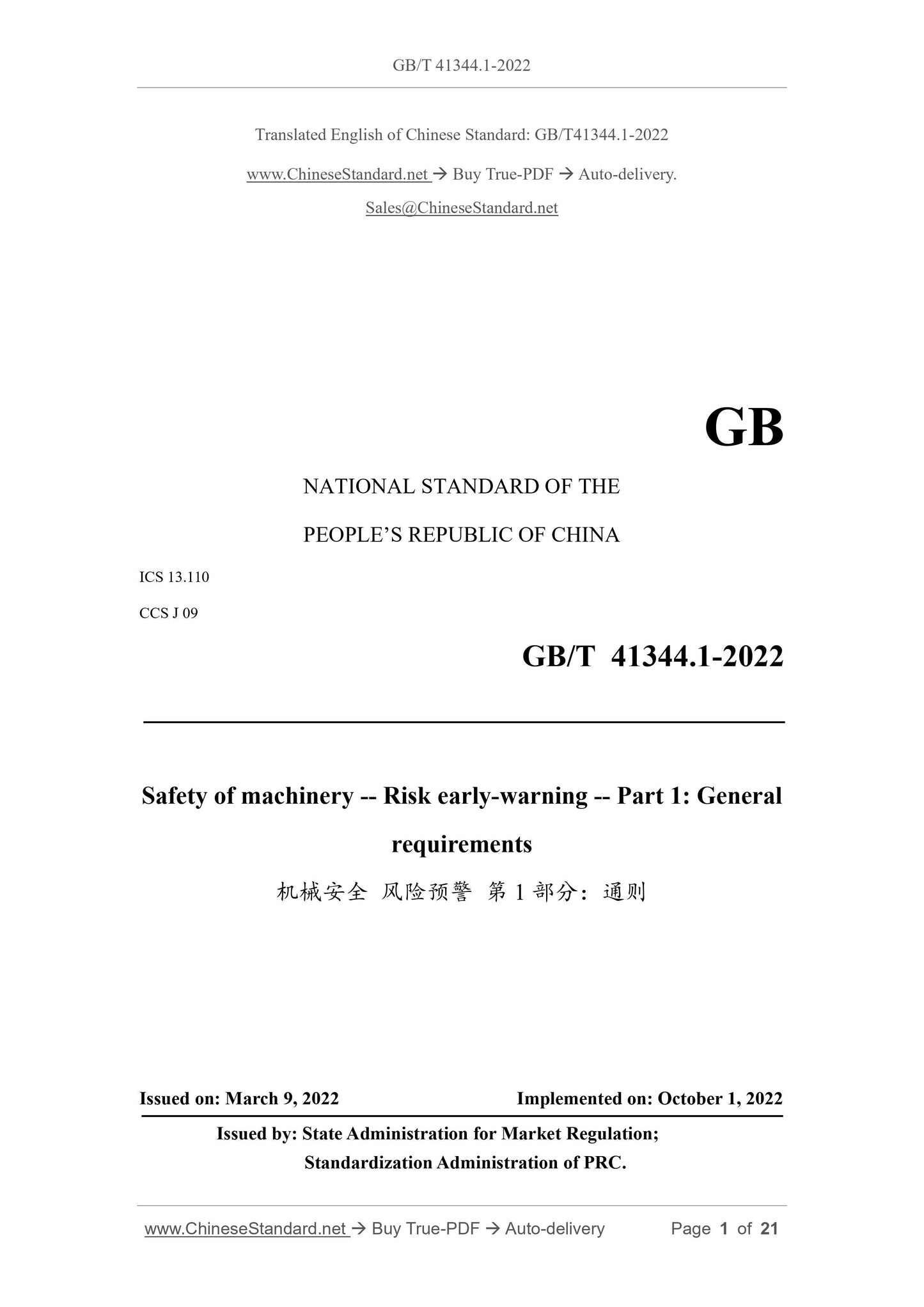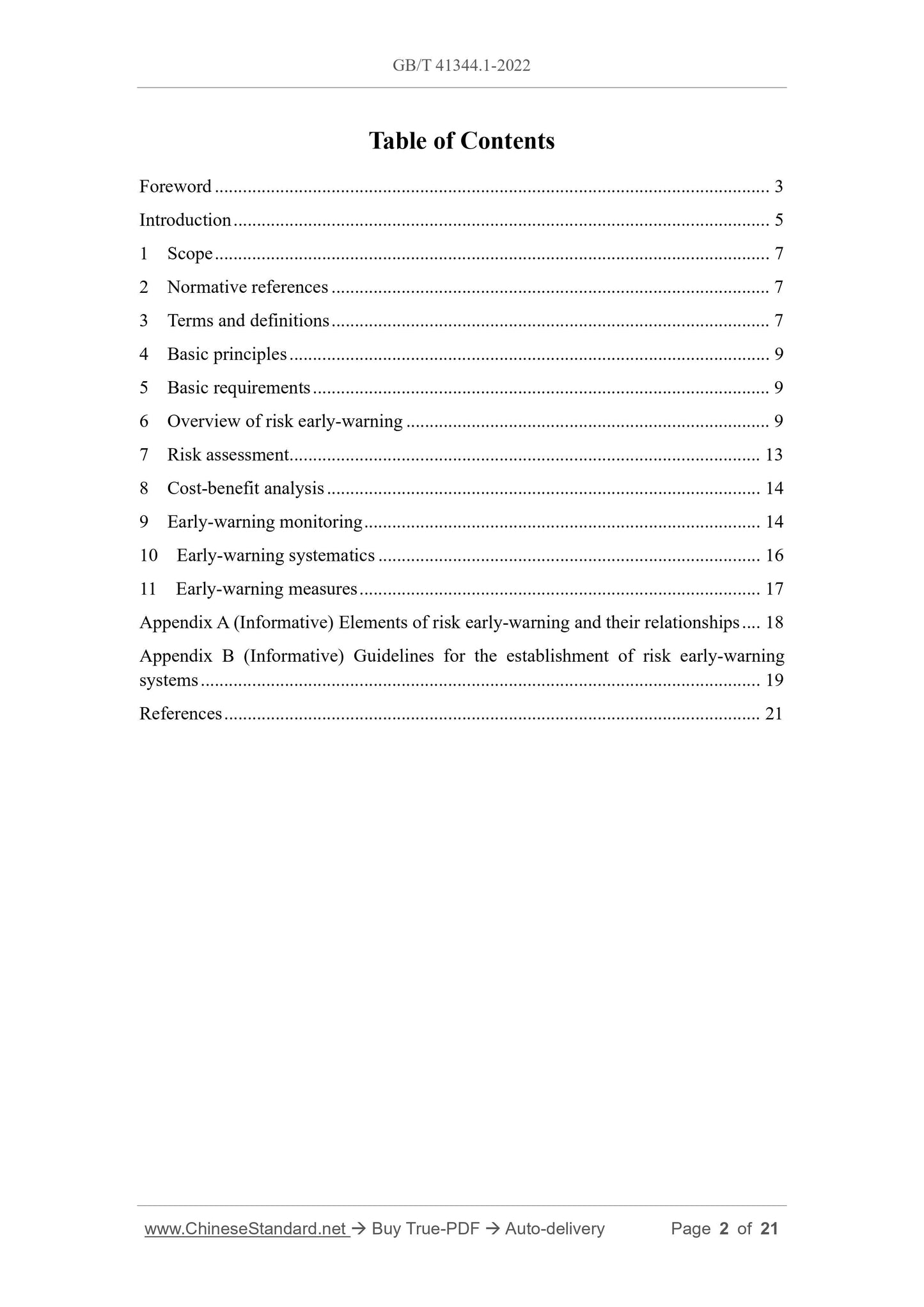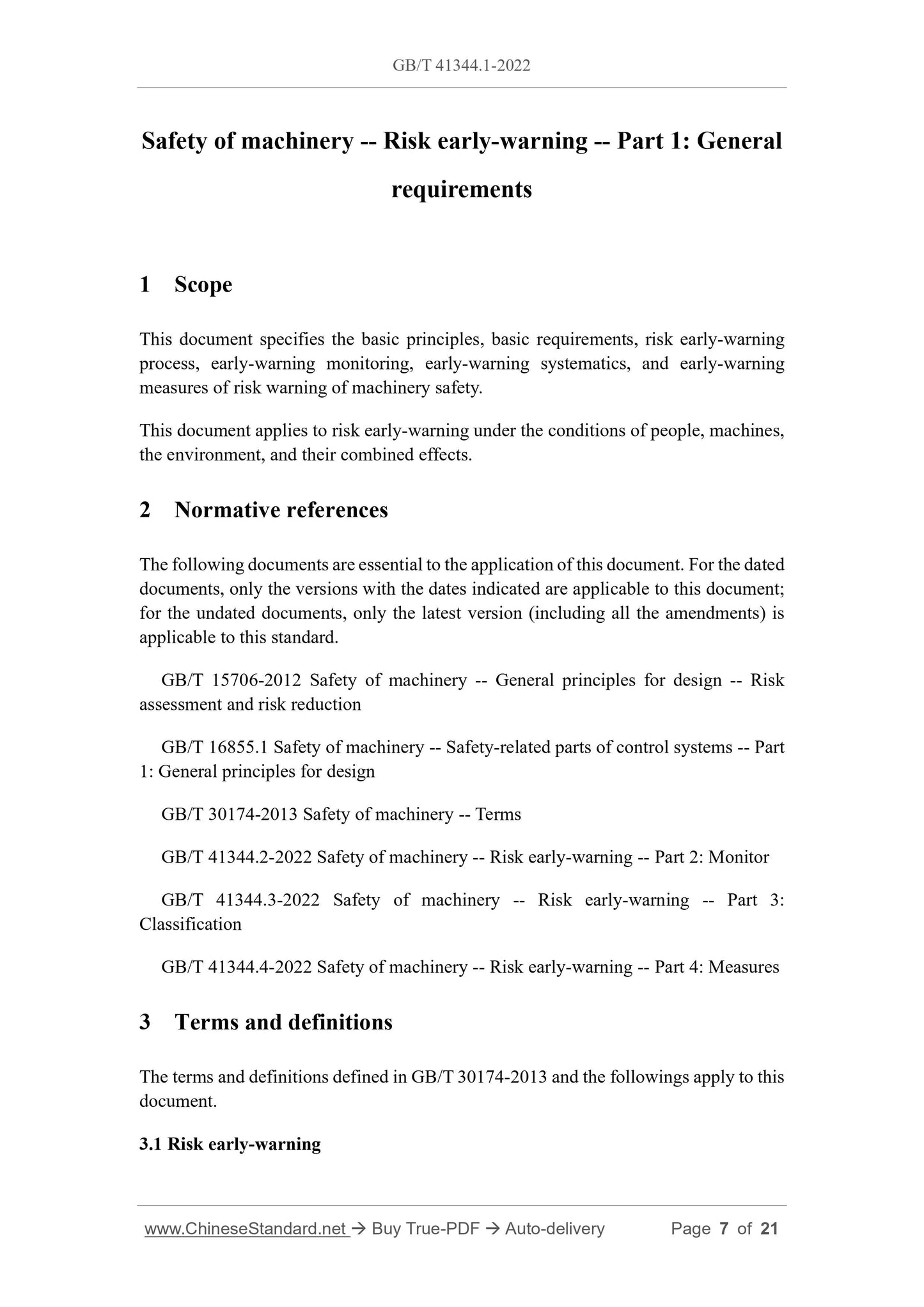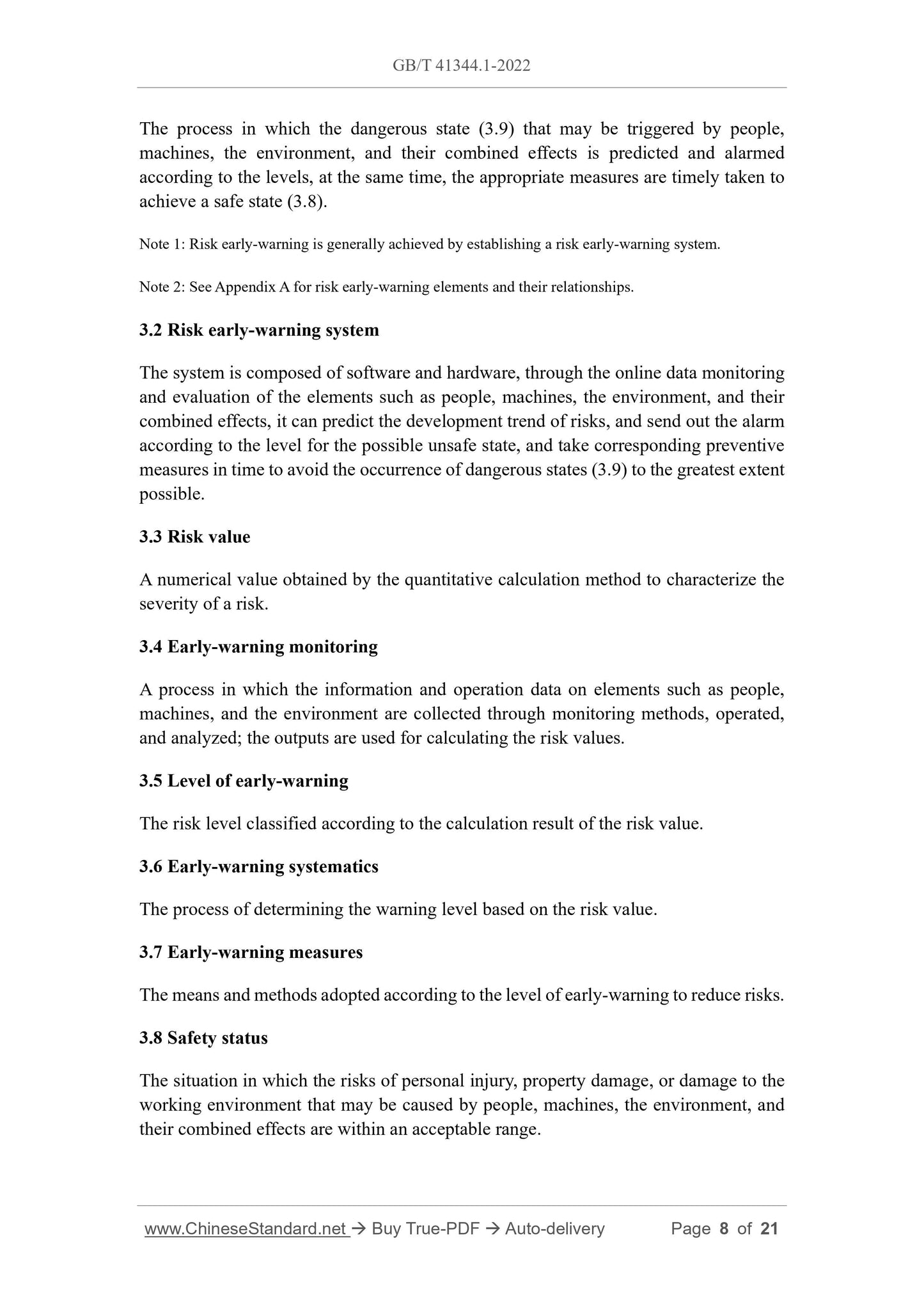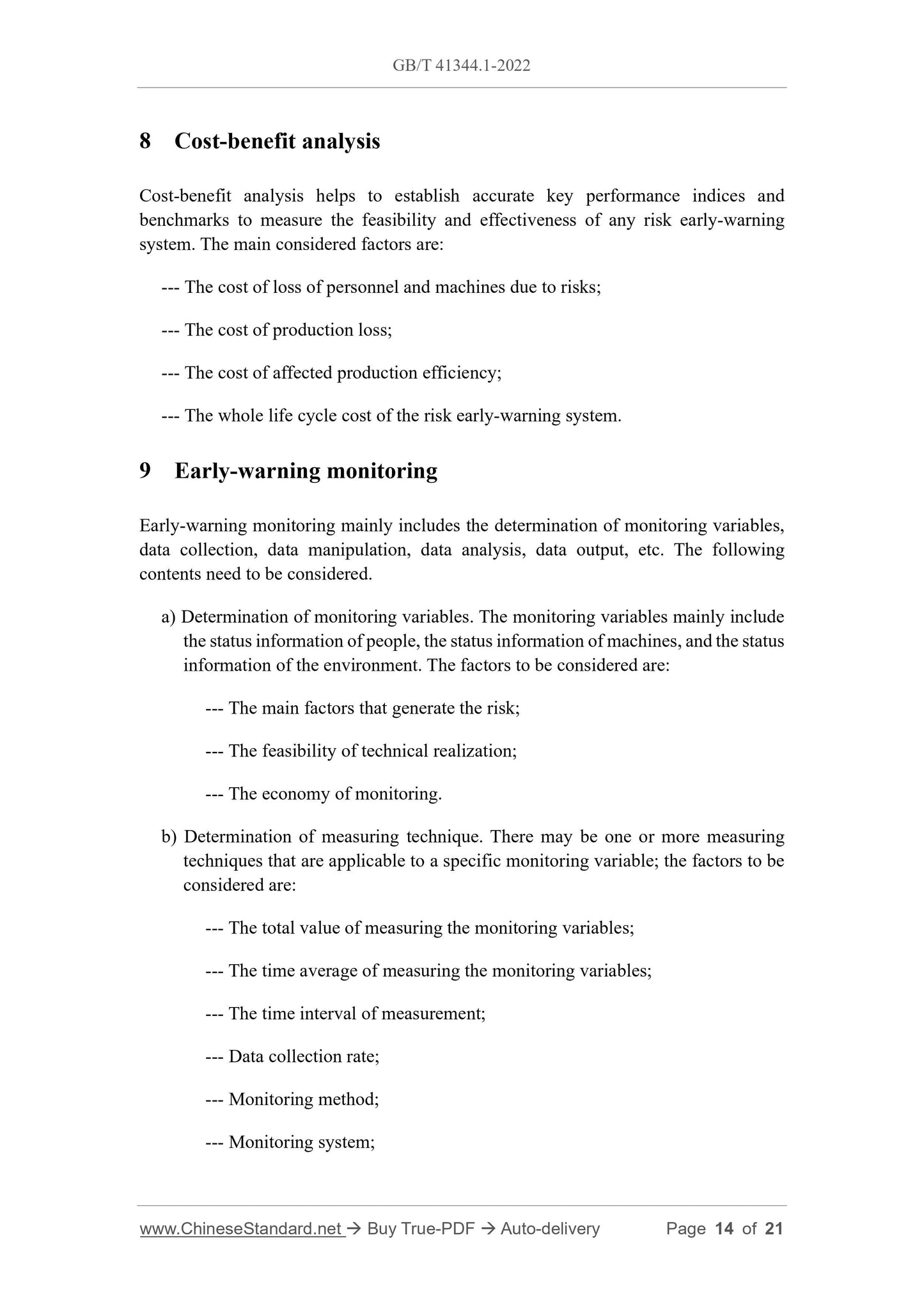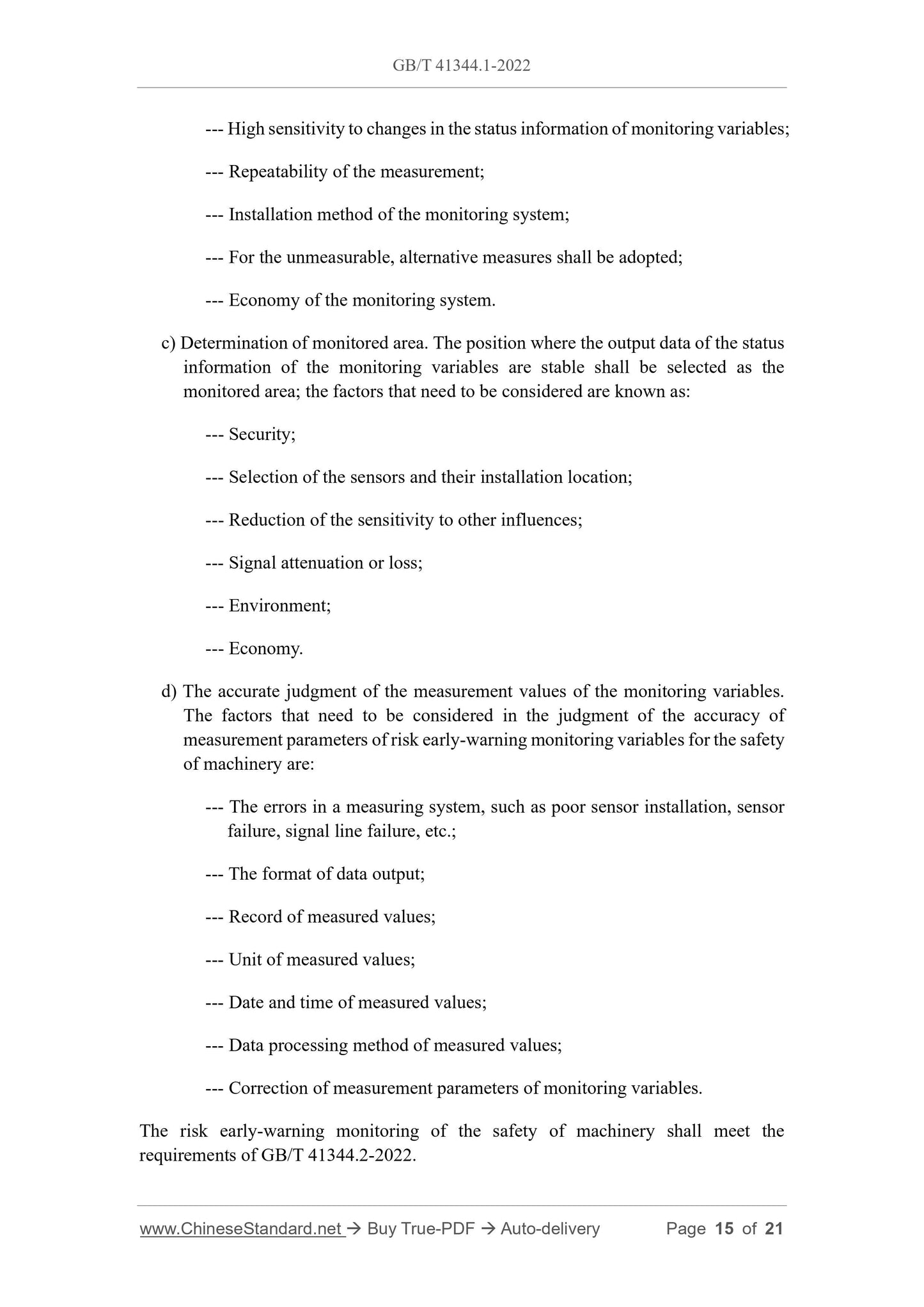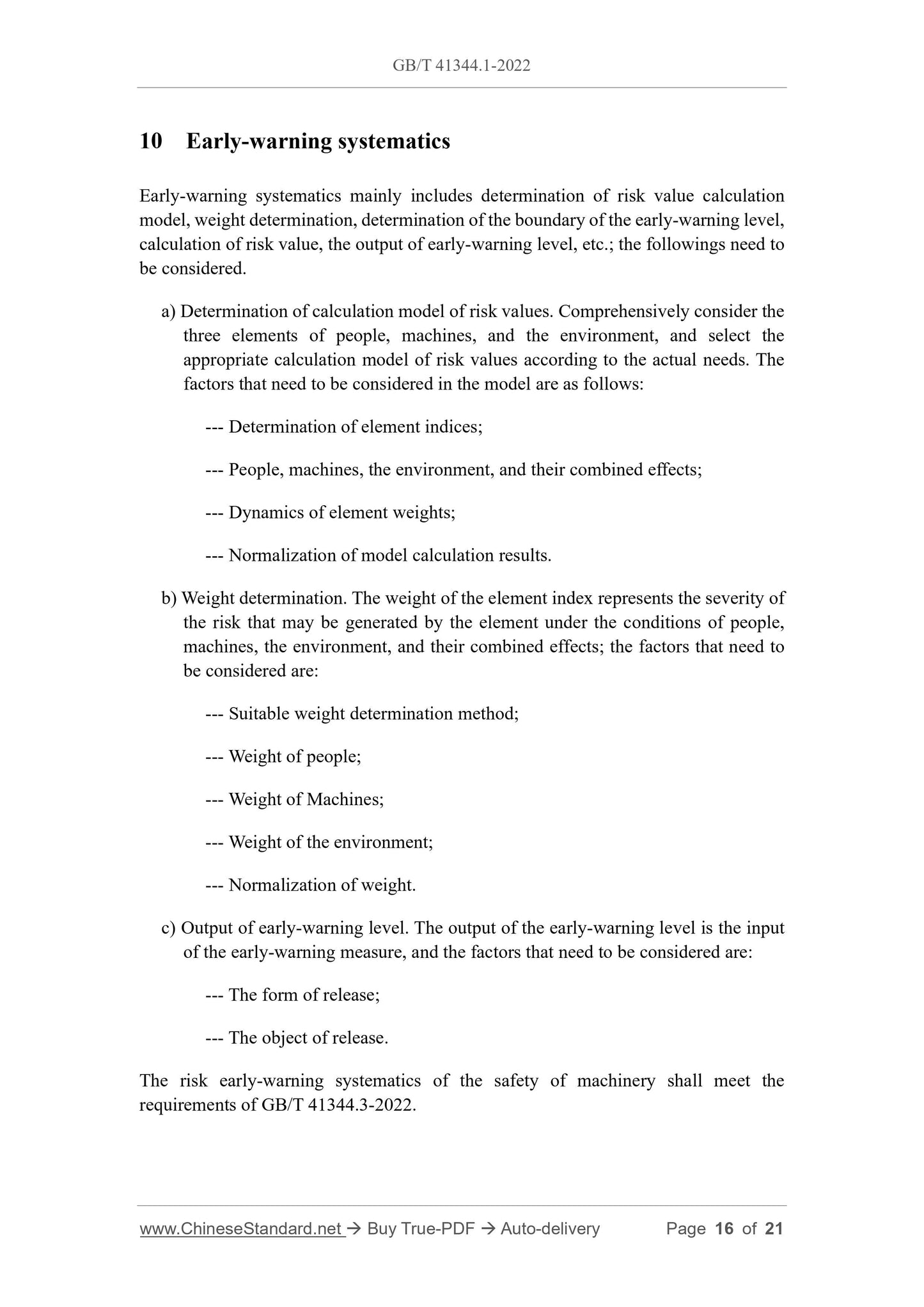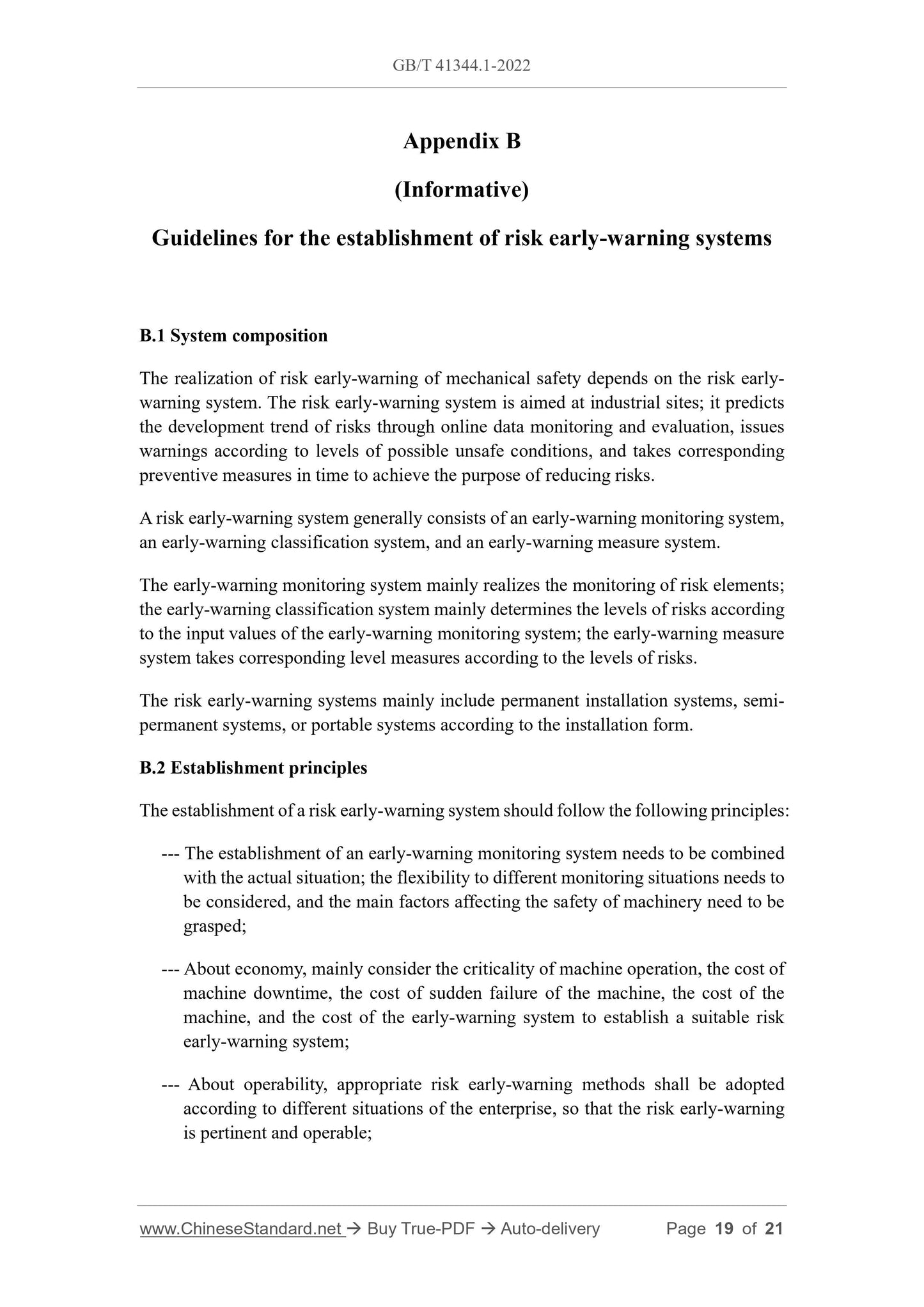1
/
of
8
www.ChineseStandard.us -- Field Test Asia Pte. Ltd.
GB/T 41344.1-2022 English PDF (GB/T41344.1-2022)
GB/T 41344.1-2022 English PDF (GB/T41344.1-2022)
Regular price
$260.00
Regular price
Sale price
$260.00
Unit price
/
per
Shipping calculated at checkout.
Couldn't load pickup availability
GB/T 41344.1-2022: Safety of machinery - Risk early-warning - Part 1: General requirements
Delivery: 9 seconds. Download (& Email) true-PDF + Invoice.
Get Quotation: Click GB/T 41344.1-2022 (Self-service in 1-minute)
Historical versions (Master-website): GB/T 41344.1-2022
Preview True-PDF (Reload/Scroll-down if blank)
GB/T 41344.1-2022
NATIONAL STANDARD OF THE
PEOPLE’S REPUBLIC OF CHINA
ICS 13.110
CCS J 09
Safety of machinery -- Risk early-warning -- Part 1: General
requirements
ISSUED ON: MARCH 9, 2022
IMPLEMENTED ON: OCTOBER 1, 2022
Issued by: State Administration for Market Regulation;
Standardization Administration of PRC.
Table of Contents
Foreword ... 3
Introduction ... 5
1 Scope ... 7
2 Normative references ... 7
3 Terms and definitions ... 7
4 Basic principles ... 9
5 Basic requirements ... 9
6 Overview of risk early-warning ... 9
7 Risk assessment ... 13
8 Cost-benefit analysis ... 14
9 Early-warning monitoring ... 14
10 Early-warning systematics ... 16
11 Early-warning measures ... 17
Appendix A (Informative) Elements of risk early-warning and their relationships ... 18
Appendix B (Informative) Guidelines for the establishment of risk early-warning
systems ... 19
References ... 21
Safety of machinery -- Risk early-warning -- Part 1: General
requirements
1 Scope
This document specifies the basic principles, basic requirements, risk early-warning
process, early-warning monitoring, early-warning systematics, and early-warning
measures of risk warning of machinery safety.
This document applies to risk early-warning under the conditions of people, machines,
the environment, and their combined effects.
2 Normative references
The following documents are essential to the application of this document. For the dated
documents, only the versions with the dates indicated are applicable to this document;
for the undated documents, only the latest version (including all the amendments) is
applicable to this standard.
GB/T 15706-2012 Safety of machinery -- General principles for design -- Risk
assessment and risk reduction
GB/T 16855.1 Safety of machinery -- Safety-related parts of control systems -- Part
1: General principles for design
GB/T 30174-2013 Safety of machinery -- Terms
GB/T 41344.2-2022 Safety of machinery -- Risk early-warning -- Part 2: Monitor
GB/T 41344.3-2022 Safety of machinery -- Risk early-warning -- Part 3:
Classification
GB/T 41344.4-2022 Safety of machinery -- Risk early-warning -- Part 4: Measures
3 Terms and definitions
The terms and definitions defined in GB/T 30174-2013 and the followings apply to this
document.
3.1 Risk early-warning
The process in which the dangerous state (3.9) that may be triggered by people,
machines, the environment, and their combined effects is predicted and alarmed
according to the levels, at the same time, the appropriate measures are timely taken to
achieve a safe state (3.8).
Note 1: Risk early-warning is generally achieved by establishing a risk early-warning system.
Note 2: See Appendix A for risk early-warning elements and their relationships.
3.2 Risk early-warning system
The system is composed of software and hardware, through the online data monitoring
and evaluation of the elements such as people, machines, the environment, and their
combined effects, it can predict the development trend of risks, and send out the alarm
according to the level for the possible unsafe state, and take corresponding preventive
measures in time to avoid the occurrence of dangerous states (3.9) to the greatest extent
possible.
3.3 Risk value
A numerical value obtained by the quantitative calculation method to characterize the
severity of a risk.
3.4 Early-warning monitoring
A process in which the information and operation data on elements such as people,
machines, and the environment are collected through monitoring methods, operated,
and analyzed; the outputs are used for calculating the risk values.
3.5 Level of early-warning
The risk level classified according to the calculation result of the risk value.
3.6 Early-warning systematics
The process of determining the warning level based on the risk value.
3.7 Early-warning measures
The means and methods adopted according to the level of early-warning to reduce risks.
3.8 Safety status
The situation in which the risks of personal injury, property damage, or damage to the
working environment that may be caused by people, machines, the environment, and
their combined effects are within an acceptable range.
8 Cost-benefit analysis
Cost-benefit analysis helps to establish accurate key performance indices and
benchmarks to measure the feasibility and effectiveness of any risk early-warning
system. The main considered factors are:
--- The cost of loss of personnel and machines due to risks;
--- The cost of production loss;
--- The cost of affected production efficiency;
--- The whole life cycle cost of the risk early-warning system.
9 Early-warning monitoring
Early-warning monitoring mainly includes the determination of monitoring variables,
data collection, data manipulation, data analysis, data output, etc. The following
contents need to be considered.
a) Determination of monitoring variables. The monitoring variables mainly include
the status information of people, the status information of machines, and the status
information of the environment. The factors to be considered are:
--- The main factors that generate the risk;
--- The feasibility of technical realization;
--- The economy of monitoring.
b) Determination of measuring technique. There may be one or more measuring
techniques that are applicable to a specific monitoring variable; the factors to be
considered are:
--- The total value of measuring the monitoring variables;
--- The time average of measuring the monitoring variables;
--- The time interval of measurement;
--- Data collection rate;
--- Monitoring method;
--- Monitoring system;
--- High sensitivity to changes in the status information of monitoring variables;
--- Repeatability of the measurement;
--- Installation method of the monitoring system;
--- For the unmeasurable, alternative measures shall be adopted;
--- Economy of the monitoring system.
c) Determination of monitored area. The position where the output data of the status
information of the monitoring variables are stable shall be selected as the
monitored area; the factors that need to be considered are known as:
--- Security;
--- Selection of the sensors and their installation location;
--- Reduction of the sensitivity to other influences;
--- Signal attenuation or loss;
--- Environment;
--- Economy.
d) The accurate judgment of the measurement values of the monitoring variables.
The factors that need to be considered in the judgment of the accuracy of
measurement parameters of risk early-warning monitoring variables for the safety
of machinery are:
--- The errors in a measuring system, such as poor sensor installation, sensor
failure, signal line failure, etc.;
--- The format of data output;
--- Record of measured values;
--- Unit of measured values;
--- Date and time of measured values;
--- Data processing method of measured values;
--- Correction of measurement parameters of monitoring variables.
The risk early-warning monitoring of the safety of machinery shall meet the
requirements of GB/T 41344.2-2022.
10 Early-warning systematics
Early-warning systematics mainly includes determination of risk value calculation
model, weight determination, determination of the boundary of the early-warning level,
calculation of risk value, the output of early-warning level, etc.; the followings need to
be considered.
a) Determination of calculation model of risk values. Comprehensively consider the
three elements of people, machines, and the environment, and select the
appropriate calculation model of risk values according to the actual needs. The
factors that need to be considered in the model are as follows:
--- Determination of element indices;
--- People, machines, the environment, and their combined effects;
--- Dynamics of element weights;
--- Normalization of model calculation results.
b) Weight determination. The weight of the element index represents the severity of
the risk that may be generated by the element under the conditions of people,
machines, the environment, and their combined effects; the factors that need to
be considered are:
--- Suitable weight determination method;
--- Weight of people;
--- Weight of Machines;
--- Weight of the environment;
--- Normalization of weight.
c) Output of early-warning level. The output of the early-warning level is the input
of the early-warning measure, and the factors that need to be considered are:
--- The form of release;
--- The object of release.
The risk early-warning systematics of the safety of machinery shall meet the
requirements of GB/T 41344.3-2022.
Appendix B
(Informative)
Guidelines for the establishment of risk early-warning systems
B.1 System composition
The realization of risk early-warning of mechanical safety depends on the risk early-
warning system. The risk early-warning system is aimed at industrial sites; it predicts
the development trend of risks through online data monitoring and evaluation, issues
warnings according to levels of possible unsafe conditions, and takes corresponding
preventive measures in time to achieve the purpose of reducing risks.
A risk early-warning system generally consists of an early-warning monitoring system,
an early-warning classification system, and an early-warning measure system.
The early-warning monitoring system mainly realizes the monitoring of risk elements;
the early-warning classification system mainly determines the levels of risks according
to the input values of the early-warning monitoring system; the early-warning measure
system takes corresponding level measures according to the levels of risks.
The risk early-warning systems mainly include permanent installation systems, semi-
permanent systems, or portable systems according to the installation form.
B.2 Establishment principles
The establishment of a risk early-warning system should follow the following principles:
--- The establishment of an early-warning monitoring system needs to be combined
with the actual situation; the flexibility to different monitoring situations needs to
be considered, and the main factors affecting the safety of machinery need to be
grasped;
--- About economy, mainly consider the criticality of machine operation, the cost of
machine downtime, the cost of sudden failure of the machine, the cost of the
machine, and the cost of the early-warning system to establish a suitable risk
early-warning system;
--- About operability, appropriate risk early-warning methods shall be adopted
according to different situations of the enterprise, so that the risk early-warning
is pertinent and operable;
GB/T 41344.1-2022
NATIONAL STANDARD OF THE
PEOPLE’S REPUBLIC OF CHINA
ICS 13.110
CCS J 09
Safety of machinery -- Risk early-warning -- Part 1: General
requirements
ISSUED ON: MARCH 9, 2022
IMPLEMENTED ON: OCTOBER 1, 2022
Issued by: State Administration for Market Regulation;
Standardization Administration of PRC.
Table of Contents
Foreword ... 3
Introduction ... 5
1 Scope ... 7
2 Normative references ... 7
3 Terms and definitions ... 7
4 Basic principles ... 9
5 Basic requirements ... 9
6 Overview of risk early-warning ... 9
7 Risk assessment ... 13
8 Cost-benefit analysis ... 14
9 Early-warning monitoring ... 14
10 Early-warning systematics ... 16
11 Early-warning measures ... 17
Appendix A (Informative) Elements of risk early-warning and their relationships ... 18
Appendix B (Informative) Guidelines for the establishment of risk early-warning
systems ... 19
References ... 21
Safety of machinery -- Risk early-warning -- Part 1: General
requirements
1 Scope
This document specifies the basic principles, basic requirements, risk early-warning
process, early-warning monitoring, early-warning systematics, and early-warning
measures of risk warning of machinery safety.
This document applies to risk early-warning under the conditions of people, machines,
the environment, and their combined effects.
2 Normative references
The following documents are essential to the application of this document. For the dated
documents, only the versions with the dates indicated are applicable to this document;
for the undated documents, only the latest version (including all the amendments) is
applicable to this standard.
GB/T 15706-2012 Safety of machinery -- General principles for design -- Risk
assessment and risk reduction
GB/T 16855.1 Safety of machinery -- Safety-related parts of control systems -- Part
1: General principles for design
GB/T 30174-2013 Safety of machinery -- Terms
GB/T 41344.2-2022 Safety of machinery -- Risk early-warning -- Part 2: Monitor
GB/T 41344.3-2022 Safety of machinery -- Risk early-warning -- Part 3:
Classification
GB/T 41344.4-2022 Safety of machinery -- Risk early-warning -- Part 4: Measures
3 Terms and definitions
The terms and definitions defined in GB/T 30174-2013 and the followings apply to this
document.
3.1 Risk early-warning
The process in which the dangerous state (3.9) that may be triggered by people,
machines, the environment, and their combined effects is predicted and alarmed
according to the levels, at the same time, the appropriate measures are timely taken to
achieve a safe state (3.8).
Note 1: Risk early-warning is generally achieved by establishing a risk early-warning system.
Note 2: See Appendix A for risk early-warning elements and their relationships.
3.2 Risk early-warning system
The system is composed of software and hardware, through the online data monitoring
and evaluation of the elements such as people, machines, the environment, and their
combined effects, it can predict the development trend of risks, and send out the alarm
according to the level for the possible unsafe state, and take corresponding preventive
measures in time to avoid the occurrence of dangerou...
Delivery: 9 seconds. Download (& Email) true-PDF + Invoice.
Get Quotation: Click GB/T 41344.1-2022 (Self-service in 1-minute)
Historical versions (Master-website): GB/T 41344.1-2022
Preview True-PDF (Reload/Scroll-down if blank)
GB/T 41344.1-2022
NATIONAL STANDARD OF THE
PEOPLE’S REPUBLIC OF CHINA
ICS 13.110
CCS J 09
Safety of machinery -- Risk early-warning -- Part 1: General
requirements
ISSUED ON: MARCH 9, 2022
IMPLEMENTED ON: OCTOBER 1, 2022
Issued by: State Administration for Market Regulation;
Standardization Administration of PRC.
Table of Contents
Foreword ... 3
Introduction ... 5
1 Scope ... 7
2 Normative references ... 7
3 Terms and definitions ... 7
4 Basic principles ... 9
5 Basic requirements ... 9
6 Overview of risk early-warning ... 9
7 Risk assessment ... 13
8 Cost-benefit analysis ... 14
9 Early-warning monitoring ... 14
10 Early-warning systematics ... 16
11 Early-warning measures ... 17
Appendix A (Informative) Elements of risk early-warning and their relationships ... 18
Appendix B (Informative) Guidelines for the establishment of risk early-warning
systems ... 19
References ... 21
Safety of machinery -- Risk early-warning -- Part 1: General
requirements
1 Scope
This document specifies the basic principles, basic requirements, risk early-warning
process, early-warning monitoring, early-warning systematics, and early-warning
measures of risk warning of machinery safety.
This document applies to risk early-warning under the conditions of people, machines,
the environment, and their combined effects.
2 Normative references
The following documents are essential to the application of this document. For the dated
documents, only the versions with the dates indicated are applicable to this document;
for the undated documents, only the latest version (including all the amendments) is
applicable to this standard.
GB/T 15706-2012 Safety of machinery -- General principles for design -- Risk
assessment and risk reduction
GB/T 16855.1 Safety of machinery -- Safety-related parts of control systems -- Part
1: General principles for design
GB/T 30174-2013 Safety of machinery -- Terms
GB/T 41344.2-2022 Safety of machinery -- Risk early-warning -- Part 2: Monitor
GB/T 41344.3-2022 Safety of machinery -- Risk early-warning -- Part 3:
Classification
GB/T 41344.4-2022 Safety of machinery -- Risk early-warning -- Part 4: Measures
3 Terms and definitions
The terms and definitions defined in GB/T 30174-2013 and the followings apply to this
document.
3.1 Risk early-warning
The process in which the dangerous state (3.9) that may be triggered by people,
machines, the environment, and their combined effects is predicted and alarmed
according to the levels, at the same time, the appropriate measures are timely taken to
achieve a safe state (3.8).
Note 1: Risk early-warning is generally achieved by establishing a risk early-warning system.
Note 2: See Appendix A for risk early-warning elements and their relationships.
3.2 Risk early-warning system
The system is composed of software and hardware, through the online data monitoring
and evaluation of the elements such as people, machines, the environment, and their
combined effects, it can predict the development trend of risks, and send out the alarm
according to the level for the possible unsafe state, and take corresponding preventive
measures in time to avoid the occurrence of dangerous states (3.9) to the greatest extent
possible.
3.3 Risk value
A numerical value obtained by the quantitative calculation method to characterize the
severity of a risk.
3.4 Early-warning monitoring
A process in which the information and operation data on elements such as people,
machines, and the environment are collected through monitoring methods, operated,
and analyzed; the outputs are used for calculating the risk values.
3.5 Level of early-warning
The risk level classified according to the calculation result of the risk value.
3.6 Early-warning systematics
The process of determining the warning level based on the risk value.
3.7 Early-warning measures
The means and methods adopted according to the level of early-warning to reduce risks.
3.8 Safety status
The situation in which the risks of personal injury, property damage, or damage to the
working environment that may be caused by people, machines, the environment, and
their combined effects are within an acceptable range.
8 Cost-benefit analysis
Cost-benefit analysis helps to establish accurate key performance indices and
benchmarks to measure the feasibility and effectiveness of any risk early-warning
system. The main considered factors are:
--- The cost of loss of personnel and machines due to risks;
--- The cost of production loss;
--- The cost of affected production efficiency;
--- The whole life cycle cost of the risk early-warning system.
9 Early-warning monitoring
Early-warning monitoring mainly includes the determination of monitoring variables,
data collection, data manipulation, data analysis, data output, etc. The following
contents need to be considered.
a) Determination of monitoring variables. The monitoring variables mainly include
the status information of people, the status information of machines, and the status
information of the environment. The factors to be considered are:
--- The main factors that generate the risk;
--- The feasibility of technical realization;
--- The economy of monitoring.
b) Determination of measuring technique. There may be one or more measuring
techniques that are applicable to a specific monitoring variable; the factors to be
considered are:
--- The total value of measuring the monitoring variables;
--- The time average of measuring the monitoring variables;
--- The time interval of measurement;
--- Data collection rate;
--- Monitoring method;
--- Monitoring system;
--- High sensitivity to changes in the status information of monitoring variables;
--- Repeatability of the measurement;
--- Installation method of the monitoring system;
--- For the unmeasurable, alternative measures shall be adopted;
--- Economy of the monitoring system.
c) Determination of monitored area. The position where the output data of the status
information of the monitoring variables are stable shall be selected as the
monitored area; the factors that need to be considered are known as:
--- Security;
--- Selection of the sensors and their installation location;
--- Reduction of the sensitivity to other influences;
--- Signal attenuation or loss;
--- Environment;
--- Economy.
d) The accurate judgment of the measurement values of the monitoring variables.
The factors that need to be considered in the judgment of the accuracy of
measurement parameters of risk early-warning monitoring variables for the safety
of machinery are:
--- The errors in a measuring system, such as poor sensor installation, sensor
failure, signal line failure, etc.;
--- The format of data output;
--- Record of measured values;
--- Unit of measured values;
--- Date and time of measured values;
--- Data processing method of measured values;
--- Correction of measurement parameters of monitoring variables.
The risk early-warning monitoring of the safety of machinery shall meet the
requirements of GB/T 41344.2-2022.
10 Early-warning systematics
Early-warning systematics mainly includes determination of risk value calculation
model, weight determination, determination of the boundary of the early-warning level,
calculation of risk value, the output of early-warning level, etc.; the followings need to
be considered.
a) Determination of calculation model of risk values. Comprehensively consider the
three elements of people, machines, and the environment, and select the
appropriate calculation model of risk values according to the actual needs. The
factors that need to be considered in the model are as follows:
--- Determination of element indices;
--- People, machines, the environment, and their combined effects;
--- Dynamics of element weights;
--- Normalization of model calculation results.
b) Weight determination. The weight of the element index represents the severity of
the risk that may be generated by the element under the conditions of people,
machines, the environment, and their combined effects; the factors that need to
be considered are:
--- Suitable weight determination method;
--- Weight of people;
--- Weight of Machines;
--- Weight of the environment;
--- Normalization of weight.
c) Output of early-warning level. The output of the early-warning level is the input
of the early-warning measure, and the factors that need to be considered are:
--- The form of release;
--- The object of release.
The risk early-warning systematics of the safety of machinery shall meet the
requirements of GB/T 41344.3-2022.
Appendix B
(Informative)
Guidelines for the establishment of risk early-warning systems
B.1 System composition
The realization of risk early-warning of mechanical safety depends on the risk early-
warning system. The risk early-warning system is aimed at industrial sites; it predicts
the development trend of risks through online data monitoring and evaluation, issues
warnings according to levels of possible unsafe conditions, and takes corresponding
preventive measures in time to achieve the purpose of reducing risks.
A risk early-warning system generally consists of an early-warning monitoring system,
an early-warning classification system, and an early-warning measure system.
The early-warning monitoring system mainly realizes the monitoring of risk elements;
the early-warning classification system mainly determines the levels of risks according
to the input values of the early-warning monitoring system; the early-warning measure
system takes corresponding level measures according to the levels of risks.
The risk early-warning systems mainly include permanent installation systems, semi-
permanent systems, or portable systems according to the installation form.
B.2 Establishment principles
The establishment of a risk early-warning system should follow the following principles:
--- The establishment of an early-warning monitoring system needs to be combined
with the actual situation; the flexibility to different monitoring situations needs to
be considered, and the main factors affecting the safety of machinery need to be
grasped;
--- About economy, mainly consider the criticality of machine operation, the cost of
machine downtime, the cost of sudden failure of the machine, the cost of the
machine, and the cost of the early-warning system to establish a suitable risk
early-warning system;
--- About operability, appropriate risk early-warning methods shall be adopted
according to different situations of the enterprise, so that the risk early-warning
is pertinent and operable;
GB/T 41344.1-2022
NATIONAL STANDARD OF THE
PEOPLE’S REPUBLIC OF CHINA
ICS 13.110
CCS J 09
Safety of machinery -- Risk early-warning -- Part 1: General
requirements
ISSUED ON: MARCH 9, 2022
IMPLEMENTED ON: OCTOBER 1, 2022
Issued by: State Administration for Market Regulation;
Standardization Administration of PRC.
Table of Contents
Foreword ... 3
Introduction ... 5
1 Scope ... 7
2 Normative references ... 7
3 Terms and definitions ... 7
4 Basic principles ... 9
5 Basic requirements ... 9
6 Overview of risk early-warning ... 9
7 Risk assessment ... 13
8 Cost-benefit analysis ... 14
9 Early-warning monitoring ... 14
10 Early-warning systematics ... 16
11 Early-warning measures ... 17
Appendix A (Informative) Elements of risk early-warning and their relationships ... 18
Appendix B (Informative) Guidelines for the establishment of risk early-warning
systems ... 19
References ... 21
Safety of machinery -- Risk early-warning -- Part 1: General
requirements
1 Scope
This document specifies the basic principles, basic requirements, risk early-warning
process, early-warning monitoring, early-warning systematics, and early-warning
measures of risk warning of machinery safety.
This document applies to risk early-warning under the conditions of people, machines,
the environment, and their combined effects.
2 Normative references
The following documents are essential to the application of this document. For the dated
documents, only the versions with the dates indicated are applicable to this document;
for the undated documents, only the latest version (including all the amendments) is
applicable to this standard.
GB/T 15706-2012 Safety of machinery -- General principles for design -- Risk
assessment and risk reduction
GB/T 16855.1 Safety of machinery -- Safety-related parts of control systems -- Part
1: General principles for design
GB/T 30174-2013 Safety of machinery -- Terms
GB/T 41344.2-2022 Safety of machinery -- Risk early-warning -- Part 2: Monitor
GB/T 41344.3-2022 Safety of machinery -- Risk early-warning -- Part 3:
Classification
GB/T 41344.4-2022 Safety of machinery -- Risk early-warning -- Part 4: Measures
3 Terms and definitions
The terms and definitions defined in GB/T 30174-2013 and the followings apply to this
document.
3.1 Risk early-warning
The process in which the dangerous state (3.9) that may be triggered by people,
machines, the environment, and their combined effects is predicted and alarmed
according to the levels, at the same time, the appropriate measures are timely taken to
achieve a safe state (3.8).
Note 1: Risk early-warning is generally achieved by establishing a risk early-warning system.
Note 2: See Appendix A for risk early-warning elements and their relationships.
3.2 Risk early-warning system
The system is composed of software and hardware, through the online data monitoring
and evaluation of the elements such as people, machines, the environment, and their
combined effects, it can predict the development trend of risks, and send out the alarm
according to the level for the possible unsafe state, and take corresponding preventive
measures in time to avoid the occurrence of dangerou...
Share
